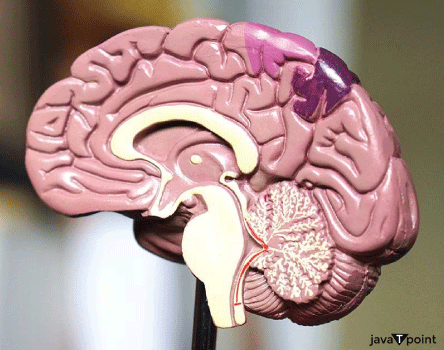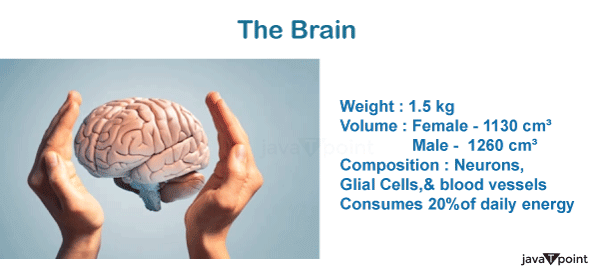Weight of the Human BrainThe amazing and intricate human brain serves as the central nervous system's control hub. It controls all body functions, as well as our thoughts, feelings, and memories. The human brain continues to captivate scientists and researchers around the world due to its complex structure and incredible powers. The neurons that make up the human brain number in the billions. These neurons constitute a huge network that permits information processing and transmission by exchanging electrochemical signals with one another. The brain is organized into various areas, each of which performs certain tasks. 
The cerebral cortex, the brain's outermost layer, is in charge of higher order cognitive processes like perception, thought, and decision-making. The frontal, parietal, temporal, and occipital lobes are the other divisions, each of which has a distinct function in our cognitive processes. The ability of the human brain to adapt and evolve over the course of a person's lifetime is one of its most astounding qualities. In reaction to new experiences, learning, and environmental stimuli, the brain is continually reconstructing itself. The four basic areas of cognition, emotion, motor control, and sensory processing can be used to broadly group the processes of the brain. Receiving and analyzing information from our surroundings via our senses is known as sensory processing. The brain combines and evaluates sensory data to give us a sense of our immediate environment. Muscle motions are coordinated by motor control, which enables us to carry out challenging activities and tasks. People can walk, talk, and perform other actions because the brain transmits impulses to the muscles. The term "cognition" refers to a broad variety of mental functions, including problem-solving, decision-making, attention, memory, and language. These cognitive processes are essential for thinking, reasoning, and understanding how the world works. Our ability to perform complex mathematical calculations, use creativity, and make wise decisions are all examples of the brain's incredible capability for cognition. Another crucial component of brain function is emotion. The limbic system of the brain, which comprises the amygdala and hippocampus, is crucial in controlling emotions and emotional reactions. Our daily lives are deeply impacted by our emotions, which have an impact on our actions, interpersonal interactions, and general wellbeing. The complexity of the human experience and our complex inner world are both influenced by the brain's capacity to feel and process emotions. The recent developments in technology like functional magnetic resonance imaging (fMRI) and electroencephalography (EEG), the study of the human brain has advanced significantly. These methods enable real-time monitoring and measurement of brain activity, giving researchers insightful information about how the brain functions. These techniques have allowed researchers to learn new things about neural networks, brain connectivity, and the underpinnings of different cognitive functions. Structure of the BrainThe cerebellum, the brainstem, and the cerebrum are the three main sections of the brain. Higher cognitive functions are controlled by the cerebrum, the largest and most developed region of the brain. It has a corpus callosum, which is a group of fibres that connects the left and right hemispheres of the brain. The frontal, parietal, temporal, and occipital lobes make up the remaining four divisions of each hemisphere. Various processes, including motor control, sensory perception, language processing, and visual processing, are carried out by these lobes. The cerebral cortex, a layer of gray matter that covers the outside of the cerebrum, is present there. It houses a lot of neurons and is in charge of information processing. The cortex is quite wavy and forms distinctive folds and grooves called sulci and gyri, respectively. By increasing the cortex's surface area through folding, more neurons can be squeezed into a small area. The cerebellum, the second important brain region, is located below the cerebrum. The cerebellum, which is situated near the base of the brain, controls posture, balance, and motor coordination. It receives sensory information from the joints and muscles and aids in fine-tuning movements. The Purkinje cells, which make up a sizable portion of the cerebellum despite it being smaller than the cerebrum in size, are essential to the cerebellum's operations. The brainstem connects the spinal cord to the brain, cerebellum, and brain. The midbrain, the pons, and the medulla oblongata are the three primary parts of the brainstem. Vital processes like breathing, heart rate, and consciousness are managed by these regions. Additionally, the brainstem functions as a relay hub for information transfer between the brain and the rest of the body. The brain is made up of glial cells and neurons at the cellular level. Information is transmitted and processed by neurons, which are the basic components of the nervous system. Through specialized connections known as synapses, they can communicate with other neurons thanks to their distinctive structure. Dendritic signals are received by neurons, which then process and transfer them up the axon to other neurons or target tissues. On the other hand, glial cells support and nourish neurons. They perform a number of tasks, including maintaining the brain's chemical environment, creating the myelin sheath around axons, and eliminating waste. In the brain, glial cells outweigh neurons and are fundamental to how it functions as a whole. The organization of the brain goes beyond its cellular composition. Additionally, it is divided up into functional units known as brain areas or nuclei. These regions have distinct functional specializations, including vision, hearing, language, and motor control. For instance, the processing of visual information is carried out by the primary visual cortex, which is housed in the occipital lobe at the back of the brain. In addition, the brain shows lateralization, a condition in which some functions are predominately found in one hemisphere. The concept of lateralization is thought to contribute to the specialization and efficiency of brain function, for example, language processing is predominantly focused in the left hemisphere for most people whereas spatial processing tends to be more prominent in the right hemisphere. It's crucial to remember that the brain's two hemispheres cooperate to integrate and share information through the corpus callosum, indicating that they are not entirely independent from one another. There are also specific structures within the brain areas that are essential to many different activities. For instance, the hippocampus plays a role in the storage and recall of memories. Processing emotions is done by the amygdala, which is also important for creating emotional memories. A collection of brain regions known as the basal ganglia are involved in learning, reward, and motor regulation. Along with its structural organization, the brain uses electrical and chemical impulses to function. Action potentials, which move through the axons, are electrical impulses that neurons use to communicate with one another. These electrical signals are transformed into chemical signals at the synapses, where neurotransmitters are produced, bind to receptors on the receiving neurons, and send the signal. The brain is also quite flexible, which means that experiences and outside influences can cause it to alter and reorganize its structure and function. Neuroplasticity is the term for this phenomenon. It is essential for the brain's ability to adapt and learn throughout life as well as for functions like memory development, skill acquisition, and healing from brain damage. The brain has an extensive network of blood arteries that deliver a steady stream of nutrients and oxygen to it. The carotid and vertebral arteries serve as the primary blood vessels for the brain. A significant portion of the body's total energy consumption-nearly 20%-is used up by the brain, which has a high need for nutrients and oxygen. About the Weight of the Human brainThe adult human brain typically weighs between 1.3 and 1.4 kilograms (2.87 and 3.09 pounds). It's crucial to remember that individual differences in brain weight might occur due to elements including age, sex, and general body size. The brain expands quickly during infancy, reaching around 80% of its adult weight by the age of two. Throughout development and adolescence, the brain's neuronal connections continue to develop and get better. The brain reaches its full size and weight by early adulthood, after which it remains largely stable with very small alterations brought on by ageing and neurodegenerative illnesses. 
The neurons, glial cells, and supporting structures that make up the brain's biological makeup make up the majority of its weight. The primary brain structures in charge of information transmission and processing are known as neurons. The neurons are supported and protected by glial cells, including astrocytes, oligodendrocytes, and microglia. It's interesting to note that cognitive or intellectual ability does not always correlate with brain weight. The organization of neural networks, the speed at which information is processed, and personal experiences are all important elements that affect intellectual capacity in addition to brain size. It's important to note that some illnesses or ailments can have an impact on brain weight. For instance, neurodegenerative diseases like Alzheimer's and Parkinson's can cause the loss of brain tissue, which lowers the brain's mass. On the other hand, some diseases, such as hydrocephalus (excessive cerebrospinal fluid collection), can result in the brain becoming larger and gaining weight. |
 For Videos Join Our Youtube Channel: Join Now
For Videos Join Our Youtube Channel: Join Now
Feedback
- Send your Feedback to [email protected]
Help Others, Please Share









